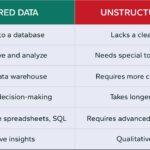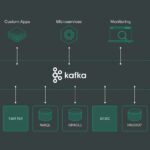In the realm of Big Data analytics, the timely extraction of meaningful insights from vast streams of data is crucial for informed decision-making. One key aspect of this process is online feature selection, which involves dynamically identifying the most relevant features in real-time data streams to optimize performance and resource utilization. In this digital age where data is continuously generated at an unprecedented scale, mastering the art of online feature selection for streaming Big Data becomes paramount. This article will delve into the key strategies and techniques to effectively optimize online feature selection in the context of Big Data analytics.
Understanding Online Feature Selection
Online feature selection is a crucial process in the realm of Big Data analytics, especially when dealing with streaming data. Unlike traditional feature selection methods that process static datasets, online feature selection operates in a dynamic environment where data comes in continuously. This requires algorithms that can adapt in real-time to changing data conditions and help in identifying the most relevant features without the need for complete data retraining.
The Importance of Feature Selection in Streaming Data
In the context of streaming Big Data, effective feature selection is vital due to several reasons:
- Real-time Analysis: Online feature selection enables immediate decision-making based on the most relevant features, critical for applications like fraud detection.
- Resource Efficiency: Reducing the number of features minimizes computational load, allowing resources to focus on more valuable data points.
- Improved Model Performance: Choosing the right subset of features can significantly enhance the performance of machine learning models.
Challenges in Online Feature Selection
While online feature selection brings numerous advantages, it also poses unique challenges:
- Dynamic Nature of Data: The features influencing outcomes might change over time, necessitating constant reevaluation.
- High-dimensional Data: As the volume of data increases, the feature space becomes more complex, complicating the selection process.
- Concept Drift: Changes in the underlying data distribution can impact model performance, making it essential to adapt feature selection techniques.
Techniques for Optimizing Online Feature Selection
To effectively optimize online feature selection for streaming big data, consider employing the following techniques:
1. Filter Methods
Filter methods evaluate feature relevance based on statistical measures independently from the model. Key criteria include:
- Correlation Coefficients: Assess the dependence of features with the target variable through Pearson or Spearman correlations.
- Mutual Information: Measure the dependency between variables, helping to identify non-linear associations.
- Chi-square Tests: Useful for categorical features, this method evaluates the independence of features relative to the target.
Filter methods are efficient and can quickly adapt to new data streams, making them suitable for real-time applications.
2. Wrapper Methods
Wrapper methods involve evaluating subsets of features based on model performance. Although more computationally intensive, they can offer better accuracy:
- Forward Selection: Begin with an empty set of features and sequentially add them based on model performance.
- Backward Elimination: Start with all features and iteratively remove the least significant ones.
These methods can be computationally demanding in a streaming context, so they require optimized algorithms and strategies to manage resource consumption.
3. Embedded Methods
Embedded methods incorporate feature selection as part of the model training process. They make feature selection and model fitting simultaneous, optimizing the process:
- Lasso (L1 Regularization): Introduces a penalty to reduce coefficients of irrelevant features to zero.
- Decision Tree-Based Methods: Models like Random Forests rank feature importance, allowing for selection based on importance scores.
Embedded methods are often favored for their effectiveness and direct integration with the model training process.
4. Streaming Algorithms
Utilizing specially designed algorithms for streaming data is essential. They allow for real-time updates without retaining the entire history of the data:
- Incremental PCA: Helps in dimensionality reduction, retaining the most informative features while updating continuously.
- Hoeffding Trees: These decision trees grow incrementally, adapting to new incoming data without re-evaluating the entire dataset.
Implementing Online Feature Selection in Big Data Frameworks
Integrating online feature selection techniques into Big Data frameworks can greatly streamline processes. Here are popular tools and libraries to consider:
1. Apache Spark
Apache Spark’s MLlib module offers a suite of algorithms for feature selection, including filter and embedded techniques that are optimized for big data environments:
- Feature Extraction: Utilize techniques like Chi-squared and Pearson correlation available in Spark’s MLlib for filter-based selection.
- Decision Trees: Leverage embedded methods, such as feature importance scoring in tree-based models.
2. Apache Flink
With its powerful stream processing capabilities, Apache Flink supports complex event processing and real-time feature selection through:
- CEP (Complex Event Processing): Enables extraction of relevant features based on patterns in data streams, allowing continuous model adaptation.
3. Scikit-learn
Incorporate the Scikit-learn library for Python, which provides a vast array of feature selection techniques. For online scenarios, consider:
- Incremental Learning Methods: Utilize partial_fit for algorithms like SGDClassifier to adaptively learn from a stream of data.
- Pipeline Integration: Combine feature selection processes with pipeline mechanisms for a seamless execution flow.
Evaluating Your Feature Selection Approach
To ensure effectiveness in your online feature selection process, continuously evaluate your approach using:
- Performance Metrics: Regularly monitor metrics such as accuracy, precision, recall, and F1-score to evaluate model improvements.
- Cross-validation: Implement k-fold cross-validation periodically to assess how well the selected features generalize to new data.
- Model Interpretability: Use techniques like SHAP (SHapley Additive exPlanations) to gain insights into feature importance and model behavior.
Tools and Libraries for Online Feature Selection
To optimize your online feature selection strategies, several tools and libraries can assist:
- Featuretools: An open-source library for automated feature engineering and selection in Python.
- River: A Python library for streaming data that incorporates online machine learning and feature selection.
- Weka: A suite of machine learning software that includes features for feature selection and evaluation.
Conclusion
Optimizing online feature selection for streaming big data is imperative for maintaining the agility and accuracy of predictive models. By adopting comprehensive techniques, leveraging frameworks like Apache Spark or Flink, and continually assessing performance, data scientists can make informed decisions that enhance their organization’s capabilities in real-time analytics.
Optimizing online feature selection for streaming big data is crucial for enhancing the efficiency and accuracy of data processing in the realm of Big Data. By leveraging advanced algorithms and strategies, organizations can effectively manage the velocity, volume, and variety of data streams, thereby extracting valuable insights in real-time to drive informed decision-making. Embracing a proactive approach to feature selection not only streamlines data analysis processes but also paves the way for innovation and competitive advantage in the ever-evolving landscape of Big Data analytics.














